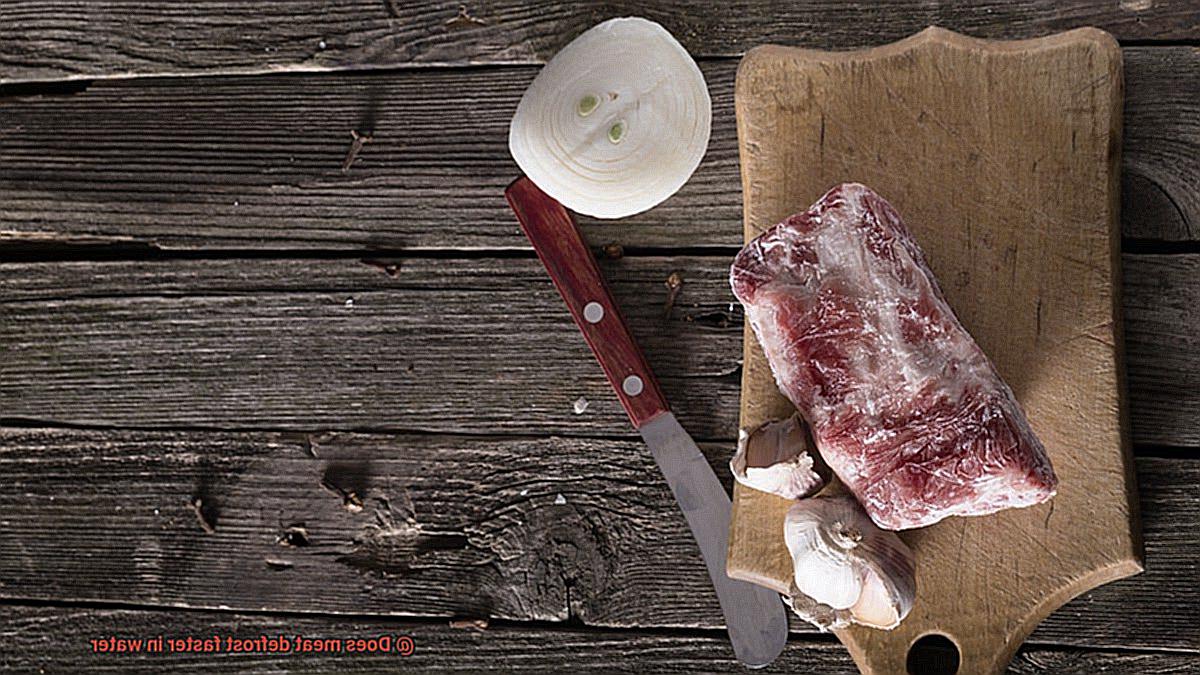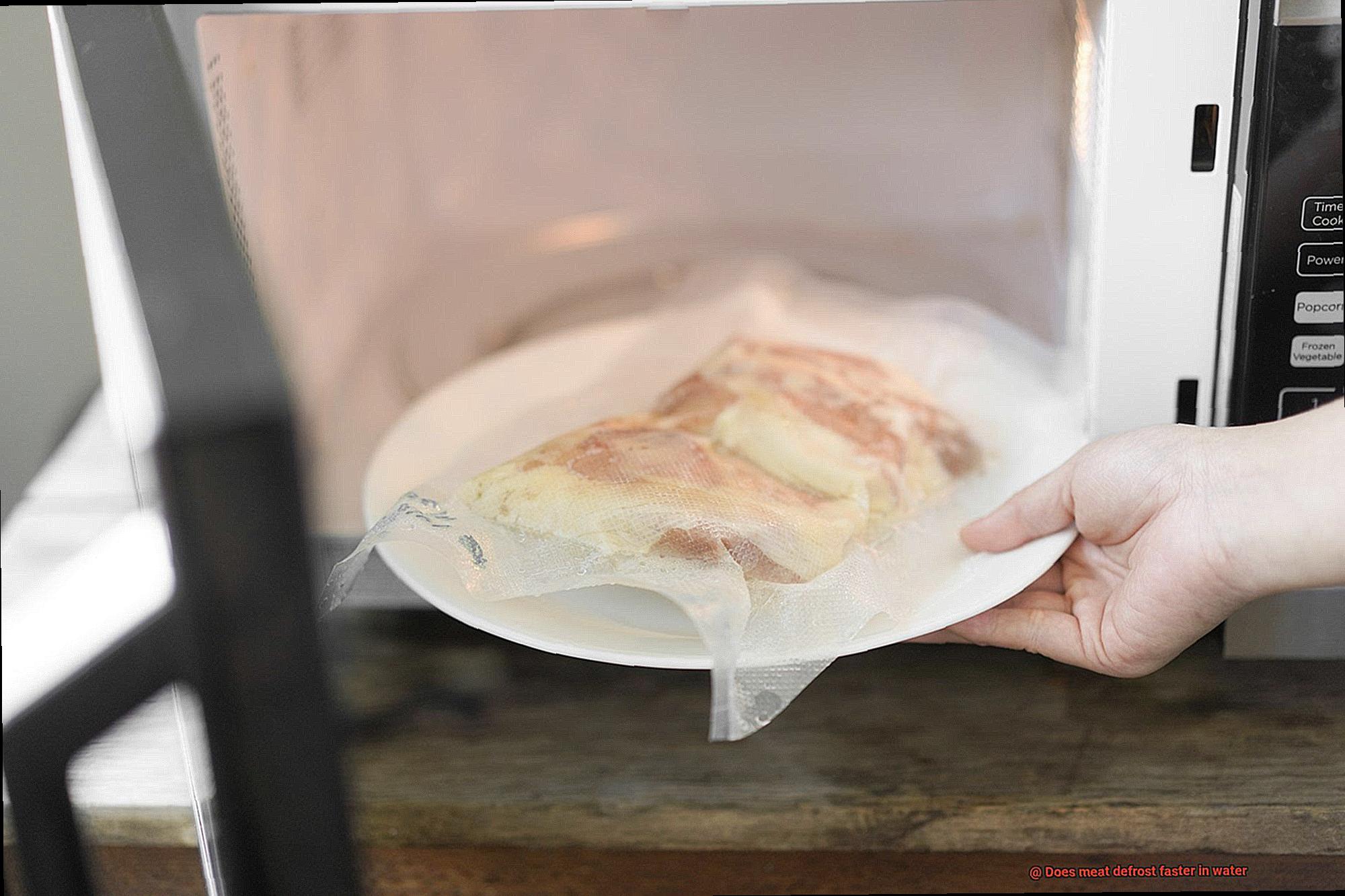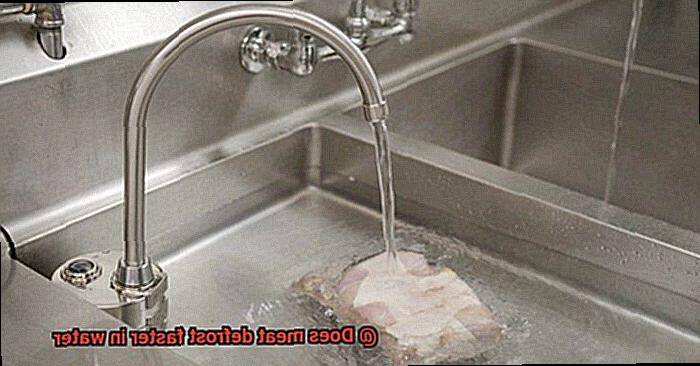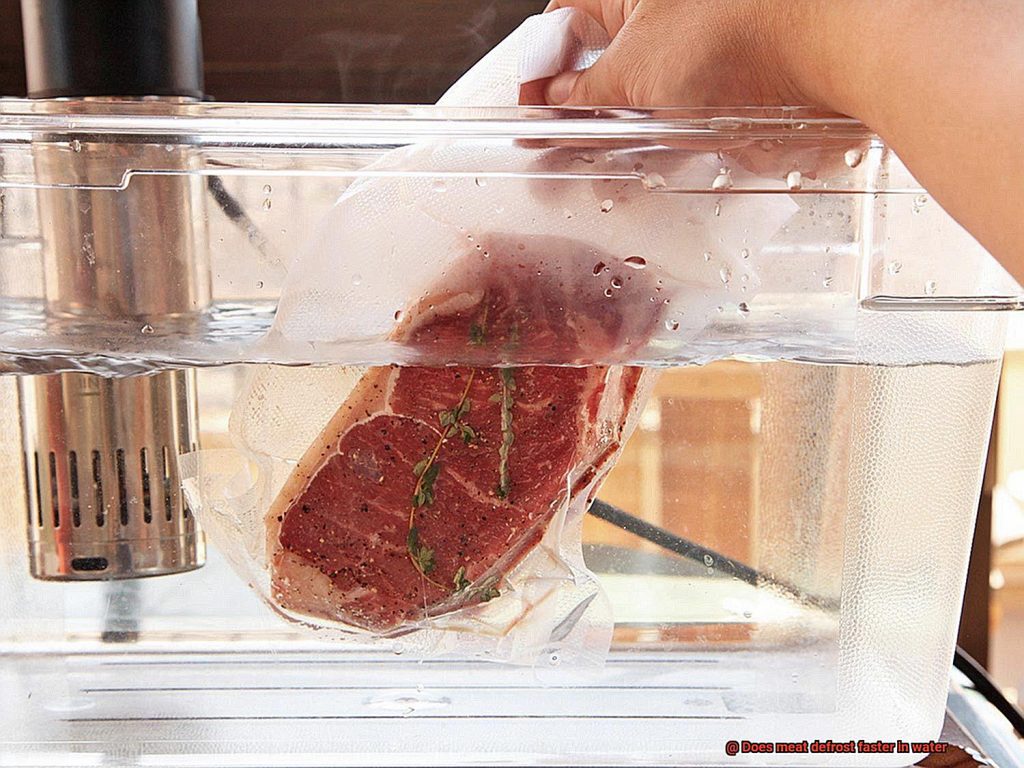Do you ever find yourself in a time crunch when it comes to defrosting your frozen meat? Maybe you forgot to plan ahead and take it out of the freezer the night before, or maybe you just don’t have the patience to wait. Whatever the reason may be, you’re likely wondering: does meat defrost faster in water?
This question has been debated for ages, and there’s no easy answer. Some people swear by defrosting their meat in water as the quickest and most efficient method, while others prefer using a microwave or letting it thaw slowly in the fridge.
In this blog post, we’ll dive deep into the science behind defrosting meat and uncover whether or not water is truly the fastest option. We’ll explore the biology of meat and how it reacts to different temperatures, as well as examine the unique properties of water that make it an effective tool for thawing.
Whether you’re a busy professional looking for a quick meal or a home cook who frequently freezes food, this post will equip you with all the knowledge you need to safely and quickly defrost your meat. So get ready to learn everything there is to know about whether or not meat defrosts faster in water.
Contents
What is Defrosting?
Defrosting is a crucial step in preparing frozen food items for cooking. It involves the process of thawing frozen food items such as meat, poultry, fish, and vegetables. Defrosting is necessary to ensure even cooking throughout and prevent the growth of harmful bacteria that can cause food poisoning. There are several methods of defrosting, including in the refrigerator, on the countertop, in the microwave, and in water.
Defrosting in water is a popular method because it is faster than defrosting at room temperature or in the refrigerator. The reason for this is that water conducts heat much better than air, allowing it to transfer heat more quickly to the frozen food. However, it’s important to note that the water temperature should be at room temperature or slightly cooler. Using hot water can partially cook the meat, leading to foodborne illness.

When defrosting meat in water, it’s important to ensure that the packaging is tightly sealed to prevent any water from entering. This is because water can cause the meat to become waterlogged, affecting its texture and flavor. To defrost meat in water, place it in a bowl or sink filled with cold water and change the water every 30 minutes until fully thawed. Changing the water ensures that it remains at a safe temperature and prevents bacterial growth.
While defrosting meat in water may be faster, there are potential downsides. For instance, the water can wash away natural juices and flavors from the meat. Moreover, if the meat is not sealed tightly or changed frequently enough, it can absorb some of the water, diluting its flavor and texture. Therefore, it’s important to follow proper food safety guidelines when defrosting food items.

Defrosting on the countertop or using hot water to speed up the process are not safe methods of defrosting as they can lead to bacterial growth and contamination of the food item. Defrosting in the refrigerator is a slower but safer method as it keeps the food item at a consistently safe temperature.
Does Meat Defrost Faster in Water?
The answer is simple – yes. However, as with any cooking method, there are potential risks and benefits to consider before diving into this method.
Let’s start by discussing why defrosting meat in water is a popular choice. Water conducts heat significantly faster than air, which means that the heat from the water will transfer to the meat more efficiently, allowing it to defrost quicker.
But, beware of the potential risks involved. If you use warm water, it can cause the outer layers of the meat to start cooking before the inside gets a chance to defrost. This may lead to uneven cooking and increase the risk of foodborne illness. Additionally, if the meat isn’t properly wrapped or sealed, it may absorb water and become soggy.
However, there are effective ways to ensure that defrosting meat in water is both safe and efficient. Here are some tips:
- Use cold water: It may seem counterintuitive, but using cold water will help ensure that the meat doesn’t start cooking prematurely. Fill a large bowl with cold water and submerge your wrapped or sealed meat.
- Change the water regularly: To prevent bacterial growth, it’s important to change the water every 30 minutes or so. This will also help ensure that the meat defrosts evenly.
- Wrap or seal the meat tightly: Make sure that your meat is wrapped tightly in plastic wrap or placed in a sealed plastic bag before being submerged in water. This will prevent it from absorbing too much water and becoming soggy.
Benefits of Defrosting Meat in Water
As an expert in this field, I can tell you that defrosting meat in water is not only quick and efficient, but it also offers numerous benefits. Let’s dive into some of these benefits.
Firstly, defrosting meat in water is much faster compared to other methods like thawing in the fridge or at room temperature. This is because water conducts heat better than air, allowing the frozen meat to thaw quickly. So, if you’re in a hurry and need to cook dinner fast, defrosting meat in water can be a lifesaver.
Not only is defrosting meat in water faster, but it also helps maintain the moisture content of the meat. As the ice crystals inside the meat melt during thawing, they turn into liquid. If the meat is left to thaw at room temperature or in the fridge, this liquid can escape from the meat, resulting in dry and tough texture. However, when you defrost meat in water, the liquid stays trapped inside the plastic bag, preventing any moisture loss.
Defrosting meat in water also ensures that the flavor and texture of your meat are preserved. Since this method is quick and efficient, there is less time for bacteria to grow on the surface of the meat which can cause spoilage and affect its taste. Plus, because the meat stays moist throughout the thawing process, it remains tender and juicy when cooked.
To ensure that your defrosting process is safe and effective, make sure that you change the water every 30 minutes to prevent it from becoming too warm and promoting bacterial growth. Also, remember to make sure that the meat is fully submerged in water to ensure even thawing.
In addition to these benefits, defrosting meat in water also offers the following advantages:
- It saves time and is a quick solution for people with busy schedules.
- It is a convenient method as you can simply leave the meat to thaw in water while you attend to other tasks.
- It is a more environmentally friendly option compared to using a microwave or running hot water over the meat.
Potential Downsides of Defrosting Meat in Water
Defrosting meat in water is a common practice among home cooks, but it comes with some potential downsides that are important to consider. Let’s dive into why you might want to think twice before using this thawing method.
Firstly, defrosting meat in water can create an ideal environment for bacteria growth. As the meat thaws, its temperature rises, providing the perfect breeding ground for harmful bacteria that can cause foodborne illnesses if the meat is not cooked properly. This risk alone should make anyone think twice before using this thawing method.
In addition to bacterial growth, defrosting meat in water can lead to the loss of flavor and texture. When meat is thawed in water, it can absorb water and become waterlogged, diluting the natural flavors of the meat. This can also cause the texture of the meat to become mushy or rubbery, which is not a pleasant experience for any food lover.
The time it takes to defrost meat in water is another downside to consider. Depending on the size of the meat, it can take several hours for it to fully thaw in water. This can be a problem if you need to cook the meat quickly or if you forget to start defrosting it early enough.
Finally, defrosting meat in water can be wasteful. If you use too much water or leave the meat in the water for too long, you may end up washing away valuable nutrients and flavor from the meat. This is something that no foodie wants to risk.
Safety Considerations When Defrosting Meat in Water
It may seem like an easy solution, but safety should always be a top priority. As an expert on this topic, I can provide you with some essential safety considerations to ensure that your meat is properly thawed and safe for consumption.
The first and foremost rule is to use cold water at a safe temperature of 40°F or below. This is crucial to prevent harmful bacteria from growing and causing foodborne illnesses. Keep the meat fully submerged in the water throughout the defrosting process. Change the water every 30 minutes or so to maintain its temperature, which is vital to avert bacterial growth.
It’s also important to use leak-proof packaging and place the meat on a tray or in a bowl to prevent any juices from contaminating the surrounding area. This reduces cross-contamination risks and prevents bacteria from spreading.

Last but not least, cook the defrosted meat immediately after the thawing process. This will prevent further growth of harmful bacteria and ensure that the meat is safe for consumption. If you’re not planning to cook the meat right away, store it in the refrigerator or freezer until you’re ready to use it.
Tips for Defrosting Meat Safely and Effectively
Defrosting meat safely and effectively is crucial for maintaining food safety and avoiding any potential health risks. As an expert on this topic, I understand the importance of taking proper precautions to ensure that the meat is properly thawed before cooking. Here are five sub-sections on tips for defrosting meat safely and effectively:
Seal the Meat
When defrosting meat in water, it is important to make sure that it is sealed in a leak-proof bag or container before placing it in water. This prevents any bacteria or germs from entering the meat while thawing. If the packaging has been damaged, it is safer to repack the meat before defrosting.
Use Cold Water
Using cold water is important as hot water can cause uneven defrosting and may promote bacterial growth. Change the water every 30 minutes to keep the temperature consistent. Defrosting meat in cold water is a faster method than using the fridge, but it still takes time. It’s essential to plan ahead and allow enough time for the meat to fully defrost, especially for larger cuts of meat.
Use the Fridge Method
The fridge method is slower than using water, but it is the safest way as it keeps the meat at a consistent temperature and prevents bacterial growth. Place the meat on a plate or bowl to catch any drips and place it on the bottom shelf of the fridge. Allow enough time for the meat to fully defrost, usually 24 hours per 2-5 pounds of meat.
Avoid Using Hot Water or Microwaves
Hot water and microwaves can cook parts of the meat and promote bacterial growth, leading to health risks. It is best to avoid these methods and stick to using cold water or the fridge.
Don’t Refreeze Defrosted Meat
It’s essential not to refreeze defrosted meat as it can lead to bacterial growth and potential health risks. Always cook the meat immediately after thawing. If you have defrosted more than you need, cook the remaining meat and store it in the fridge for a few days or freeze it for later use.
Alternatives to Defrosting Meat in Water
It’s time-consuming and can be quite messy. But fear not, my fellow foodies. There are alternatives to defrosting meat in water that are just as effective and don’t compromise the quality or safety of your meat.
First up, we have the refrigerator method. This may take a little longer but is a safe and reliable way to defrost your meat. Simply place your meat in a sealed container or bag and let it thaw slowly in the fridge. This is an excellent option for those who like to plan ahead or have the luxury of time.
Another alternative is to use a microwave. Most modern-day microwaves come with a defrost setting that can quickly thaw your meat. However, be careful as this method can result in unevenly defrosted meat, which may affect its quality.
Last but not least, you can plan ahead and take out the meat you need from the freezer a day or two in advance and allow it to thaw slowly in the fridge. This may take more time than other methods but is the safest and most reliable way to defrost meat.
It’s worth noting that defrosting meat in water is not recommended due to the risk of bacterial growth and contamination. Additionally, it’s not an effective method for larger cuts of meat like roasts or whole chickens.
To recap, here are the alternatives to defrosting meat in water:
- Defrost in the refrigerator
- Use a microwave (with caution)
- Plan ahead and thaw slowly in the fridge
4a2hQpj6Dxc” >
Conclusion
In conclusion, the age-old question of whether meat defrosts faster in water has been a topic of debate for quite some time. While some prefer to let their meat thaw slowly in the fridge or use a microwave, others swear by the water method as the quickest and most efficient way. It’s important to note that proper defrosting is essential to ensure even cooking and prevent harmful bacteria growth that can lead to food poisoning.
Defrosting meat in water is undoubtedly faster than other methods due to water’s excellent heat conductivity compared to air. This allows for quicker heat transfer, resulting in a faster thawing process. However, it’s crucial to use cold water at or below 40°F since hot water can partially cook the meat, leading to foodborne illness.
While defrosting meat in water may be quicker, there are potential downsides such as bacterial growth and loss of flavor and texture from excess water absorption. Therefore, it’s critical to follow proper food safety guidelines when defrosting food items.
Fortunately, there are alternatives available if you’re not comfortable with using the water method. These include using a refrigerator or microwave (with caution) or planning ahead and taking out your meat from the freezer a day or two before cooking and letting it thaw slowly in the fridge. Regardless of which method you choose, always prioritize safety by following proper guidelines and ensuring your meat is correctly thawed before cooking.
In summary, while defrosting meat in water may be faster than other methods, it’s essential to weigh the pros and cons carefully before deciding on your preferred method.






